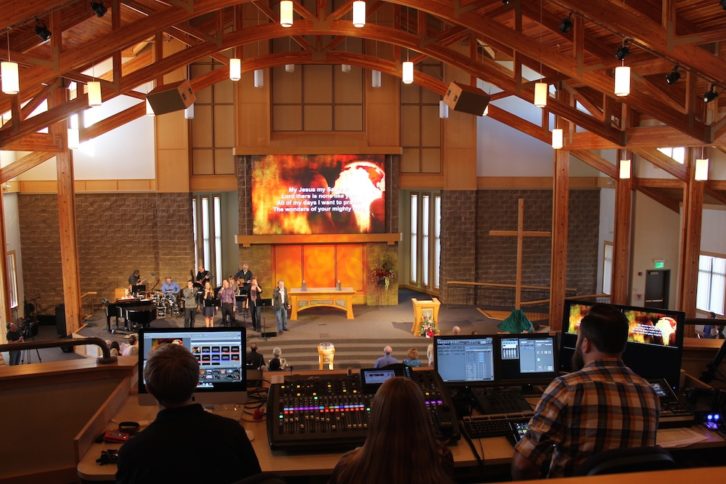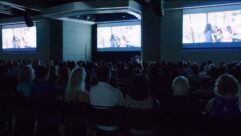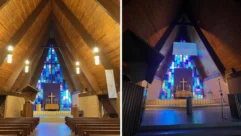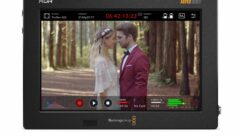
In this edition of the SVC Podcast, SVC Contributing Editor Bennett Liles talks with Kevin Crow of Excel AV Group in Maple Grove, Minnesota about the complete sound, video and lighting renovation done by them at Hope Lutheran Church in Fargo, North Dakota. Kevin outlines the design of the new sound system that uses Danley loudspeakers run on Powersoft amplifiers, Sennheiser wireless microphones and a Midas DL251/X32 mixing console. The acoustic timing challenges and electrical situation at the church are also discussed.
Links of interest:
- Excel AV Group in Maple Grove, Minnesota
- The Powersoft Duecanali 3904 amplifiers powering the main house
- The Danley SH96 speakers used for the main house sound system
- The Midas M32 digital mixing console selected for the sanctuary
- A YouTube video outlining the project
Download Podcast Here:
https://s3.amazonaws.com/nb-svc/public/public/125-1_Excel_AV_Hope_Luther…
From Sound & Video Contractor Magazine, this is the SVC Podcast with Kevin Crow of Excel AV Group. Show notes for the podcast are available on the web site of Sound & Video Contractor Magazine at svconline.com.
When a church decides to move toward a more contemporary worship style it can have big implications for lights, video and sound. The Hope Lutheran Church in Fargo, North Dakota made the move and they called in Excel AV Group to handle the whole renovation and upgrade. Kevin Crow was there and now he’s here to tell us all about the project. That’s coming right up on the SVC Podcast.
Kevin, it’s great to have you back with us on the SVC Podcast from Excel AV Group in Maple Grove, Minnesota.
That’s correct.
And Excel AV Group was called in by the Hope Lutheran Church in Fargo, North Dakota to shoot the works with a complete sound, video and lighting renovation.
Correct.
So tell us about Excel AV Group. You do a lot of churches.
Our market is about 80 percent house of worship. We’ve got a bunch of other commercial type clients, but definitely have a lot of work with the church community, which is wonderful; all types, all sizes, all denominations. [Timestamp: 1:24]
Well, churches can present some interesting acoustic problems since they’re usually designed to make the pastor sound pretty lofty and reverberant. I saw some pictures of this place. Describe for us the sanctuary at Hope Lutheran Church. It looks like a hardwood ceiling with exposed wood beams and that kind of thing.
You know it’s not too bad acoustically, but it’s definitely more on the live, traditional side. In order to have good sound in a space like that you need directional speakers, and what they had were very old; probably a 20-year-old loudspeaker system that definitely needed an update with today’s technology. And we also looked at the kind of footprint that would go into the space for loudspeakers and something that we could stain the speakers to blend in with the wood, something that didn’t hang down too far. And so a lot of times when we’re looking for full total balance and something that we can not make a big footprint in the space we immediately think of Danley Sound Labs and the Synergy Horn technology. And to make it even more important to this church, the tech director, Justin, was just very, very into Danley anyway. Justin Morken is his name and he was very into Danley and had heard the product at other facilities and demos and liked it. So we decided to go in that direction and the sound update worked out great. They also had a tremendous amount of video improvements that they wanted to make as well, so we did that too. [Timestamp: 3:01]
And you went exclusively with Powersoft on the amplifiers. What was the main attraction of their amps for this job?
There’s a lot of amplifiers out there and it doesn’t have to be only one brand when we look at amps. There’s definitely a lot of high output amplifiers on the market, but when it comes to something that dollar for output – and if you need a high level of output – it’s really hard to make a case that Powersoft isn’t one of the best choices on the market. So we were able to get a lot of output, not just for the Danley Synergy Horns, but for the Danley DBH218 subwoofer. It’s a very power-hungry subwoofer – it requires a lot of power – and the Powersoft was just a great choice for that, so it worked out really good. [Timestamp: 3:50]
And I mentioned at the outset here that this place has a lot of exposed beams and you had to rig speakers to hang from this area. Did that present any special problems keeping everything looking right?
Nothing that isn’t normal to us doing it all the time, over and over and over again. It wasn’t – there’s certainly a lot harder installs that we’ve been involved with than that one. The nice thing about having it all exposed and open is there wasn’t things to work around. Like sometimes we have to work around ceiling clouds and cloud systems and a lot of other types of things. I mean this isn’t as easy as a bar joint’s warehouse room for sure, but it wasn’t out of the ordinary when you work with houses of worship and especially ones that are traditional. [Timestamp: 4:40]
There were several sound zones you had to break this up into. I think there was the floor zone, the balcony and you even had a special coverage area under the balcony.
Yeah, and this is a very common thing too. So we have the main seating area. You’ve got the balcony and then you’ve got under balcony. And with the main seating area, one of the nicest things about Danley’s Synergy Horn technology is because it’s so directional you get very little stage spill. We call it stage spill. There’s probably a better name for it, but we’re just able to get the sound on the main level seating area and off the stage, less feedback. We actually used a Tannoy Coax V8; it’s a V8 product which is very similar sounding, actually, to Danley – very clear, very open coax-type speaker for the under balcony. And then we’ve got the Danley FM60, it’s one of their smaller Synergy Horn boxes for the upper balcony, which happens to be where the sound booth is. That’s something where through our setup of the system with the digital signal processor and all the routing and the delays and so forth, we can actually set up the same volume level and roughly the same EQ tuning that we’ve got on the main floor so that when you’re mixing up in the balcony you’re hearing it at the same SPL level and room EQ that we’ve got on the main floor. So then the person mixing is hearing it the way they should, and that was the problem before we put in the system is that it was very different up in the balcony versus on the main floor and that’s a very, very common problem with a lot of auditorium sound reinforcement systems, is the difference between the sound in the seating area versus where the mix engineer is. So we were able to even it out and make it pretty much the same anywhere. It’s very, very clear and there’s very little phasing because that’s just the way that that Synergy Horn technology works that Tom Danley invented quite a few years ago now. [Timestamp: 6:57]
I guess one of the basic tasks here was to get all the arrival times to jive together in the various sound zones so how was it getting the timing right for the whole sanctuary?
Right. So if you’re using SIA SmaartLive, which is what we use when we tune systems, we can set up impulse response and we can look at when arrival times are for the sound is coming from the main speakers versus delay fills and we can line it up really accurate actually. We get used to doing that kind of thing and it’s pretty straightforward. The digital signal processor that we use is Symetrix Radius, which is an amazing processor for the money; really good value. Their software is exceptional when it comes to ProSound loudspeaker systems for EQ and delay and limiting and all the compression and all the great type of EQ abilities that you’d want from a DSP. It’s limitless, really. [Timestamp: 8:03]
Now the front-of-house control position being up in the balcony is pretty common in churches. I’ve worked a few where they put you almost into a closet up in the balcony. You used a Midas DL251 in this. Is that the actual mixer?
The Midas DL51 is the input box and one of the brains to it, but the church actually took delivery a little bit late on the Midas M32, which is the actual surface. And then they also used the Behringer P16 personal monitor mixes, so they got away from quite a bit of the stage noise by getting their musicians on personal monitor mixers. And then Justin Morken, who I think I mentioned is the church tech director, has the iPad app for the Midas and can walk down on the main level and control the console remotely if he needs to. So it’s very – it’s a great value. The Midas is a killer value and the M32 and very compatible with the Behringer P16 mixers and that type of thing. [Timestamp: 9:10]
And that’s such a feeling of freedom being able to walk around and mix and not be chained to the console. How do they do the stage monitoring for the singers? Do they set that up from auxes on the front-of-house mixer?
They have a couple of wedge monitors for vocalists and the music leader, but for the most part the musicians, the band members, are on the Behringer P16 personal monitor mixers and that’s all part of the Midas and Behringer system that they have running. [Timestamp: 9:40]
Yeah, the musicians like nothing better than to be able to control all of that themselves and it really takes a load off of the front-of-house audio person.
Mm-hmm.
And it was a Sennheiser wireless mic system that you put in for them there?
Yeah. They’re using Sennheisers and when it comes to quality of sound from wireless it’s hard to beat price per dollar on the Sennheiser equipment.
A lot of churches use Sennheiser wireless gear. Now, how do they do that? Do they have the pastor on a wireless system?
The pastor is. I think he’s using a DPA d:fine over-the-air mic to the Sennheiser body pack. There’s a bunch of handheld Sennheiser mics, which Sennheiser has incredible quality sounding heads for their different wireless mics, and that’s what they run pretty much. [Timestamp: 10:28]
It’s always great when you can get a pastor to use a head-worn mic and that really is a hit with the sound people and makes their job easier.
Mm-hmm.
Alright, Kevin. It’s been great hearing about this one and we’ll get more into the video and lighting part of the project in part two. Kevin Crow from Excel AV Group in Maple Grove, Minnesota and the sound, video and lighting renovation at the Hope Lutheran Church in Fargo, North Dakota. When did you guys do this? What time of year were you up there?
We designed it in May and June of 2014 and it was all installed by September for the fall kickoff. [Timestamp: 11:03]
I was going to say that if you’re going to be in Fargo any later in the year that could present some interesting logistical problems, too.
Oh, we rough it. It’s fine. You just get on the freeway and you hope there isn’t a snowstorm so they don’t shut down the interstate. [Timestamp: 11:18]
Alright, well let’s hope that doesn’t happen to your guys. And we’ll see you again in part two, Kevin.
Thank you.
Thank you for being here with us for the SVC Podcast with Kevin Crow. Show notes are available on the website of Sound & Video Contractor Magazine at svconline.com. In part two Kevin will tell us about the complete video and lighting upgrade Excel AV also did for Hope Lutheran Church. Next time on the SVC Podcast.









